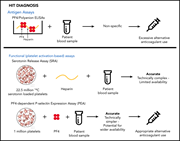Issue Archive
Table of Contents
BLOOD COMMENTARIES
BLOOD SPOTLIGHT
Preleukemic and leukemic evolution at the stem cell level
In this Blood Spotlight, Stauber et al provide an overview of emerging concepts about clonal evolution in myeloid malignancy initiation, progression, and relapse. The authors highlight recent work proposing premalignant stem cells as a potential and clinically relevant source of clonal heterogeneity.
CLINICAL TRIALS AND OBSERVATIONS
A fixed-duration, measurable residual disease–guided approach in CLL: follow-up data from the phase 2 ICLL-07 FILO trial
Clinical Trials & Observations
Brief Report
How long patients with chronic lymphocytic leukemia (CLL) should receive ibrutinib-based first-line therapy is unknown. Michallet and colleagues provide an update of an ongoing phase 2 trial, reporting that those patients who achieve complete remission and have no minimal residual disease (MRD) have robust benefit at 3 years after 15 months of fixed-duration therapy. These data add weight to the idea that MRD-guided therapy may assist in optimizing personalized therapy for patients with CLL.
HEMATOPOIESIS AND STEM CELLS
A wave of bipotent T/ILC-restricted progenitors shapes the embryonic thymus microenvironment in a time-dependent manner
IMMUNOBIOLOGY AND IMMUNOTHERAPY
CLEC12A and CD33 coexpression as a preferential target for pediatric AML combinatorial immunotherapy
Willier and colleagues report that the expression of target molecules for immunotherapy in pediatric acute myeloid leukemia (AML) differs from expression profiles in adult AML. On the basis of their study of 36 cases, they identify CLEC12A and CD33 as preferential immunotargets for combined targeting in pediatric AML. They also nominate the combination of CD33 and FLT3 as immunotargets specific for KMT2A-mutated infant AML.
MYELOID NEOPLASIA
Heat shock factor 1 (HSF1-pSer326) predicts response to bortezomib-containing chemotherapy in pediatric AML: a COG report
Clinical Trials & Observations
PLATELETS AND THROMBOPOIESIS
Antibody-induced procoagulant platelets in severe COVID-19 infection
The prothrombotic state observed in patients with COVID-19 has many dimensions. Althaus et al identify circulating procoagulant platelets in patients with severe disease and demonstrate that immunoglobulin G antibodies induced in response to SARS-CoV-2 can activate platelets by triggering apoptosis. Correlative associations suggest that this is relevant for thrombus formation in patients with severe disease.
THROMBOSIS AND HEMOSTASIS
Recombinant VWF fragments improve bioavailability of subcutaneous factor VIII in hemophilia A mice
Management of hemophilia A depends on repeated intravenous injections of factor VIII, and development of effective subcutaneous delivery is desirable but challenging. Vollack-Hesse et al describe the use of recombinant von Willebrand factor fragments to protect factor VIII from phospholipids in subcutaneous tissues, increasing bioavailability and hemostatic activity but not antigenicity in murine models. These data provide the rationale for clinical trials of this strategy.
A prospective, blinded study of a PF4-dependent assay for HIT diagnosis
Diagnosis of heparin-induced thrombocytopenia (HIT) can be a challenge. Pathogenic HIT antibodies selectively activate platelet factor 4 (PF4)–treated platelets. In a prospective, blinded study of more than 400 patients suspected of having HIT, Samuelson Bannow and colleagues demonstrate high accuracy of the technically simple PF4-dependent P-selectin expression assay (PEA) relative to the gold standard (serotonin release assay). Widespread use of the PEA could improve diagnosis and change clinical practice.
TRANSPLANTATION
Repurposing a novel anti-cancer RXR agonist to attenuate murine acute GVHD and maintain graft-versus-leukemia responses
VASCULAR BIOLOGY
Neutrophil extracellular traps promote fibrous vascular occlusions in chronic thrombosis
LETTER TO BLOOD
Venetoclax and ibrutinib for patients with relapsed/refractory chronic lymphocytic leukemia
Clinical Trials & Observations
Genomic subtypes may predict the risk of central nervous system recurrence in diffuse large B-cell lymphoma
Ollila et al address a challenging problem: can the risk for central nervous system (CNS) relapse in patients with diffuse large B-cell lymphoma be predicted better on a molecular basis? They report that most tumors with CNS recurrence have recognizable molecular features that fall into two categories: those that resemble primary CNS lymphoma and those that resemble high-grade lymphoma. These data suggest that it is time to revisit identification of patients who may benefit from CNS prophylaxis, while highlighting how challenging that is.
Long-term follow-up of lenalidomide and rituximab as initial treatment of follicular lymphoma
Clinical Trials & Observations
BLOOD WORK
ERRATA
-
Cover Image
Cover Image
![issue cover]()
Immunofluorescence staining of fibroblasts isolated from a patient with chronic thrombosis. Activated fibroblasts are shown in red (fibroblast activation protein), with mesenchymal marker in green (α-smooth muscle actin), secreted extracellular matrix protein in white (fibronectin), and nuclei in blue (DAPI [4′,6-diamidino-2-phenylindole]). See the article by Sharma et al on page 1104.
- PDF Icon Front MatterFront Matter
- PDF Icon Table of ContentsTable of Contents
- PDF Icon Back MatterBack Matter
- PDF Icon Editorial BoardEditorial Board
Advertisement intended for health care professionals
Email alerts
Advertisement intended for health care professionals













Layered immunity of the developing thymus